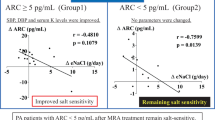Summary
The activity of two aldosterone antagonists in reversing the urinary electrolyte changes induced by the mineralocorticoid fludrocortisone was examined in healthy subjects. Between 2–10 h after treatment there were dose-related increases in sodium excretion and the urine log 10 Na/K ratio, but no significant changes in urine volume, potassium concentration, or potassium excretion. Between 12–16 h after treatment there were dose-related increases in urine sodium excretion and the log 10 Na/K ratio. Unexpectedly, there were significant dose-relatedincreases in potassium excretion despite significant dose-related reductions in urinary potassium concentration. The paradoxical increases in potassium excretion were attributed to dose-related increases in urine volume in the same period. These observations may explain the increased potassium excretion occasionally observed during clinical use of aldosterone antagonists and suggest that potassium excretion in man is influenced by the urine flow rate.
Similar content being viewed by others
References
Liddle, G. W.: Specific and non-specific inhibition of mineralocorticoid activity. Metabolism10, 1021–1030 (1961)
Kagawa, C. M.: Anti-aldosterones. In: Methods in hormone research, (ed. R. I. Dorfman), Vol. 3, pp. 351–414. New York, London: Academic Press 1964
Manitius, A., Suchecki, T.: The mode of action and clinical use of spirolactones. Mater. Med. Pol.4, 83–88 (1972)
Liddle, G. W.: Aldosterone antagonists. Arch. intern. Med.102, 998–1004 (1958)
Coppage, W. S., Liddle, G. W.: Mode of action and clinical usefulness of aldosterone antagonists. Ann. N. Y. Acad. Sci.88, 815–821 (1960)
Edmonds, C. J., Wilson, G. M.: The action of hydroflumethiazide in relation to adrenal steroids and potassium loss. Lancet1960 I, 505–509
Morrison, R. S.: In: The clinical use of aldosterone antagonists. (ed. F. C. Bartter), p. 83. Oxford: Blackwell 1960
Laragh, J. H.: In: The clinical use of aldosterone antagonists, (ed. F. C. Bartter), p. 87. Oxford: Blackwell 1960
Faloon, W. W.: The effects of changing sodium and potassium intakes on the action of spirolactones. In: The clinical use of aldosterone antagonists, (ed. F. C. Bartter), p. 115, Oxford: Blackwell 1960
Romani, J. D., Keller, A.: Etude des effets metaboliques de la spirolactone SC 9420 chez l'homme. Ann. Endocr.22, 357–366 (1961)
Georgopoulos, A. J., Dustan, H., Page, I. H.: Spironolactone in hypertensive patients. Arch. intern. Med.108, 389–392 (1961)
Morrison, R. S., Sebestyen, C. S.: Contrasting effects of hydrochlorothiazide and spironolactone. Clin. Res.9, 206 (1961)
Jick, H., Morrison, R. S., Moore, E. W., Chalmers, T. C.: Metabolic studies on the effects of spironolactone. Metabolism12, 381–387 (1963)
Ross, E. J.: Aldosterone and its antagonists. Clin. Pharmacol. Ther.6, 65–106 (1965)
Ross, E. J.: Human assay of electrolyte-active steroids and their antagonists. Clin. Sci23, 197–202 (1962)
Ramsay, L., Harrison, I., Shelton, J., Tidd, M.: The relative potency of prorenoate potassium and spironolactone in normal man. Clin. Pharmacol. Ther.18, 391–400 (1975)
Johnson, B. B.: Bioassay of adrenal cortical steroids on the basis of electrolyte excretion by rats. Effects of 11-desoxy and 11-oxy steroids. Endocrinology54, 196–208 (1954)
Kagawa, C. M.: Adrenocortical antagonists. In: Evaluation of drug activities: pharmacometrics, (eds. D. R. Laurence, A. L. Bacharach), Vol. 2, pp. 745–762. London, New York: Academic Press 1964
Cochran, W. G., Cox, G. M.: In: Experimental designs, p. 80. New York, London, Sydney: Wiley 1957
Armitage, P.: In: Statistical methods in medical research. Oxford, London, Edinburgh, Melbourne: Blackwell 1971
Duarte, C. G., Chomety, F., Giebisch, G.: Effect of amiloride, ouabain, and furosemide on distal tubular function in the rat. Amer. J. Physiol.221, 632–640 (1971)
Giebisch, G.: Renal potassium excretion, In: The kidney. Morphology, biochemistry, physiology, Vol. 3, pp 329–382. New York: Academic Press 1971
Schultze, R. G.: Recent advances in the physiology and pathophysiology of potassium excretion. Arch. intern. Med.131, 885–897 (1973)
Kunau, R. T., Webb, H. L., Borman, S. C.: Characteristics of the relationship between the flow rate of tubular fluid and potassium transport in the distal tubule of the rat. J. clin. Invest.54, 1488–1495 (1974)
Newman, E. V.: In: The clinical use of aldosterone antagonists, (ed. F. C. Bartter), p. 75. Oxford: Blackwell 1960
Berliner, R. W., Kennedy, T. J., Hilton, J. G.: Renal mechanisms for excretion of potassium. Amer. J. Physiol.162, 348–367 (1950)
Malnic, G., Klose, R. M., Giebisch, G.: Micropuncture study of distal tubular potassium and sodium transport in rat nephron. Amer. J. Physiol.211, 529–547 (1966)
Gantt, C. L.: Observations on the mechanism of action of steroidal spirolactones. Metabolism11, 1061–1063 (1962)
Crabbe, J.: The role of aldosterone in the renal concentration mechanism in man. Clin. Sci.23, 39–46 (1962)
Goonaratna, C. F. W., Wrong, O. M.: Assessment of urine-concentrating ability in man: effect of fludrocortisone and urea in enhancing response to vasopressin. Clin. Sci. Mol. Med.48, 269–278 (1975)
Gantt, C. L., Synek, J. H.: Observations on mechanism of potassium excretion due to administration of hydrochlorothiazide. Proc. Soc. exp. Biol. (N.Y.)106, 27–28 (1961)
Gillenwater, J. Y., Webster, G. D.: Chlorothiazide-induced kaliuresis after adrenalectomy. J. Pharmacol. exp. Ther.156, 366–368 (1967)
Author information
Authors and Affiliations
Rights and permissions
About this article
Cite this article
Ramsay, L.E., Harrison, I.R., Shelton, J.R. et al. Paradoxical potassium excretion in response to aldosterone antagonists. Eur J Clin Pharmacol 11, 101–105 (1977). https://doi.org/10.1007/BF00562899
Received:
Revised:
Accepted:
Issue Date:
DOI: https://doi.org/10.1007/BF00562899




